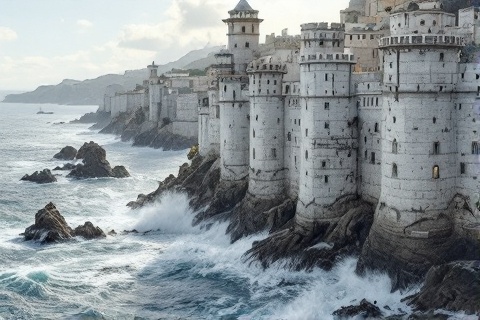
Vinyamar: The Forgotten Halls of Turgon
Unveiling the Coastal Citadel of Tolkien's Middle-earth
The Foundation of Vinyamar

Vinyamar stood as one of the earliest and most magnificent settlements of the
Noldor in Beleriand, established in the
region of Nevrast during the First Age. This coastal realm lay
between the highlands of Dor-lómin to the north and the
great Western Sea, serving as the first permanent dwelling of Turgon and his
people after their arrival in Middle-earth from
Valinor.
The mighty fortress-city was constructed at the foot of Mount Taras, where its
steep slopes met the western shores of Beleriand. Its position was carefully
chosen by Turgon himself, who recognized the natural defensive advantages of
building beneath the mountain's protective shadow while maintaining access to
the sea.
As the first great dwelling of the Noldor in Beleriand, Vinyamar represented a
significant milestone in their return to Middle-earth. The city served as
Turgon's seat of power for nearly a century before he received a vision from
Ulmo that would lead to the creation of Gondolin,
establishing architectural and cultural patterns that would later influence the
hidden city's design.
Architectural Splendor

The walls of Vinyamar were crafted from gleaming white stone quarried from Mount
Taras itself, creating a striking contrast against the dark cliffs and blue
waters of the sea. These walls caught and reflected the light of both sun and
moon, making the city visible from great distances across the plains of Nevrast
and serving as a beacon to approaching ships.
Rising from the city's foundations were tall towers that served as both
defensive structures and symbols of Noldorin pride. These spires provided
unobstructed views across the Western Seas, allowing the Elves to maintain their
connection with the distant shores of Aman while watching for any approaches
from the water.
Within Vinyamar's walls, the Noldorin architects demonstrated their supreme
craftsmanship through intricately carved halls that celebrated their cultural
heritage. The stonework featured elaborate designs depicting scenes from Valinor
and the great journey across the Helcaraxë, preserving the history of their
people in stone.
The city's layout incorporated spacious courts and noble chambers that reflected
the grandeur of Noldorin architecture. These spaces were designed not just for
functionality but as expressions of artistic beauty, with high vaulted ceilings
and graceful archways that created an atmosphere of ethereal elegance throughout
the stronghold.
The Haven of Nevrast
Beneath Vinyamar's imposing walls lay a natural harbor, carefully enhanced by
Noldorin engineering to provide safe anchorage for vessels. This harbor offered
protection from the often-turbulent waters of the Western Sea, allowing ships to
dock safely regardless of weather conditions.
The harbor of Vinyamar served as a crucial gateway to the Western Seas,
maintaining the Noldor's connection to the waters that led back to Valinor.
Though they could never return across those waters, the harbor remained an
important symbolic and practical feature of the city's design.
The meeting point of mountain and ocean created a unique architectural challenge
that the Noldor masterfully overcame. They incorporated the natural rock
formations into their harbor design, creating a seamless blend between the
natural and constructed elements that characterized much of their architectural
philosophy.
Defensive Features

Vinyamar's strategic position against Mount Taras provided natural protection
and surveillance advantages that made it nearly impregnable from the landward
side. The fortress was built to utilize the mountain's steep slopes as part of
its defensive system, with the city's rear walls actually incorporating the
natural rock face.
The main defensive walls faced the plains of Nevrast, creating an imposing
barrier against any potential threats from the east. These fortifications were
built to the exacting standards of Noldorin military architecture, incorporating
multiple layers of defense and carefully positioned gatehouses.
The natural defenses of the area were formidable, with the mountain protecting
one flank while sheer sea cliffs guarded another. This positioning meant that
any attacking force would be forced to approach through the open plains, where
they would be easily spotted long before reaching the city.
The watchtowers of Vinyamar were positioned to maintain constant surveillance of
both land and sea approaches. These towers were staffed by keen-eyed Noldorin
guards who could spot approaching threats from great distances, whether they
came from the plains of Nevrast or the waters of Belegaer.
Gardens and Courtyards

Within Vinyamar's protective walls, the Noldor created elaborate gardens that
served as peaceful havens for the city's inhabitants. These gardens featured
plants brought from Valinor or cultivated from seeds carried across the
Helcaraxë, creating spaces of remarkable beauty that reminded the Elves of their
former home.
The city's fountains were fed by pure springs that flowed down from Mount Taras,
creating a network of waterways that brought both practical and aesthetic value
to the city. The sound of flowing water was ever-present in Vinyamar, mixing
with the distant crash of waves to create a constant melody.
The courtyards of Vinyamar showcased the finest examples of Noldorin sculptural
art, with works depicting the Valar, great deeds of the Eldar, and scenes from
life in Aman. These sculptures were crafted with such skill that they seemed
almost alive, capturing the grace and power of their subjects in enduring stone.
The Legacy of Abandoned Halls

After Turgon and his people departed for Gondolin, Vinyamar's empty chambers
retained their ancient splendor even as they stood silent and unused. The halls
remained largely untouched, preserving the grandeur of their original
construction through the years of abandonment that followed.
Throughout the abandoned city, evidence of the Noldor's legendary craftsmanship
remained visible in every corner. The intricate carvings, precise stonework, and
elegant architectural details continued to testify to the skill and artistry of
their creators long after their departure.
When Tuor arrived at Vinyamar following Ulmo's guidance, he found the arms and
armor left there by Turgon's command, including the famous shield bearing the
emblem of the Wing and Sun. These carefully preserved artifacts served their
intended purpose centuries after being placed there, demonstrating the foresight
of the Noldor.
Over the centuries following its abandonment, the sea gradually began to reclaim
portions of the once-great city. Salt spray from the ocean slowly weathered the
white stones, while sea winds carried sand and moisture into the empty halls.
Yet even in its decline, Vinyamar retained a solemn dignity that spoke of its
former glory.
